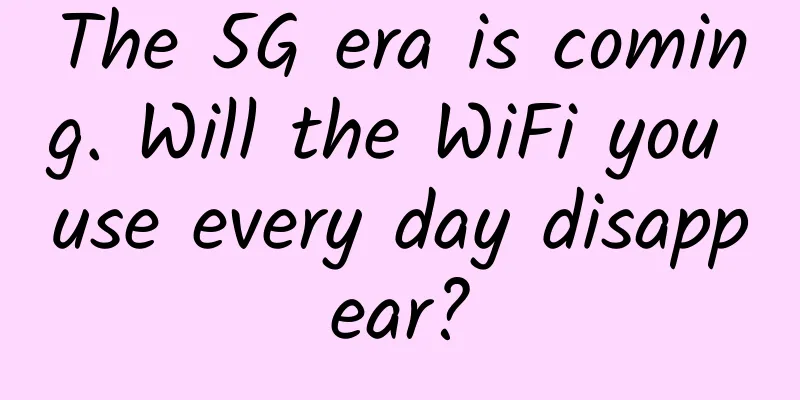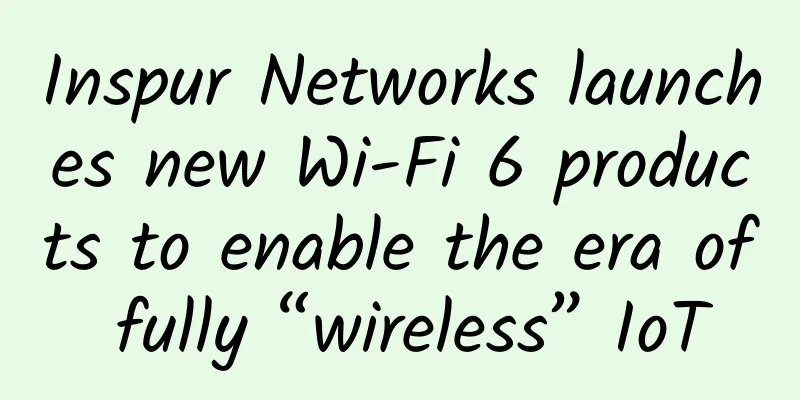Wi-Fi 6 is here, are you interested?

|
If we were to vote for the "hottest names" in the wireless technology industry in the past two years, 5G would undoubtedly top the list. However, while 5G is advancing by leaps and bounds, other wireless technologies are also not idle, and are tenaciously evolving along their own established directions in order to consolidate their bases in the increasingly fierce competition and seize opportunities to gain a larger market share. In September 2019, the Wi-Fi Alliance announced the official launch of the Wi-Fi 6 certification program authorization, which means that the Wi-Fi 6 standard has begun to be put into practice. This has made everyone focus again on Wi-Fi, an "old friend" that has always been with us but seems to have been silent for a long time.
Increasing speed Looking back at the history of Wi-Fi, the initial motivation for its creation was not to establish a king of data transmission in a wireless LAN, but simply to use a wireless technology to solve the tedious work of wiring between cash registers in stores. However, people soon realized the value of this technology, and promoted it to become the IEEE 802.11 international standard. Coupled with the rise of PCs and the support of a number of computer manufacturers, Wi-FI eventually became the only choice for high-throughput wireless data transmission in LANs. Although Wi-Fi has the convenience of "wireless", its data transmission rate has always been rivaled by the rapidly developing wired Ethernet technology. Therefore, increasing the data rate has always been a core priority in the evolution of Wi-Fi technology, and it has been proven that Wi-Fi has not disappointed everyone.
As a wireless LAN technology operating in the 2.4GHz UHF or 5GHz SHF ISM radio frequency band, the Wi-Fi standard has undergone five versions of iterative upgrades.
Figure 1, Wi-Fi standard development and comparison (Source: NXP) Wi-Fi 6, the sixth-generation specification launched by the Wi-Fi Alliance, is technically 37% faster than 802.11ac in terms of single-user data rate. By combining various new technologies, the new specification is expected to provide four times the throughput, reaching a transmission rate of 10Gbps! It can be said that this will bring the Wi-Fi user experience to a new level. Outside the highway However, if you think that Wi-Fi 6 is just another speed upgrade, you are overthinking it. In fact, the Wi-Fi Alliance has stuffed a lot of new technology into the "skin" of Wi-Fi 6. Only when you really understand it will you sincerely exclaim "It's really delicious". Let's sort out the key technologies in Wi-Fi: 1. OFDMA: Wi-Fi 6 introduces OFDMA (Orthogonal Frequency Division Multiple Access) technology in both uplink and downlink, which allows up to 30 users to share a channel simultaneously to reduce latency, increase capacity and improve efficiency. This allows Wi-Fi 6 to achieve stability comparable to that of cellular networks. In previous Wi-Fi specifications, a "Best Effort" networking mode was adopted, and sometimes even when the Wi-Fi signal was strong, the network could not be connected, greatly affecting the user experience. The stronger networking stability and reliability brought by OFDMA technology will also make Wi-Fi 6's application scenarios more diverse. 2. MU-MIMO: MU-MIMO (Multi-User MIMO) is not a new technology introduced by Wi-Fi 6, but it has been greatly optimized based on the previous generation specifications. Multi-user MU-MIMO was introduced in Wi-Fi 5 Wave 2, which only supported four downstream and one upstream simultaneous connections, while Wi-Fi 6 can handle eight upstream and downstream data streams, making multi-user support easier. 3. 1024-QAM: In terms of modulation, Wi-Fi 6 enables 1024-QAM encoding to increase the amount of data transmitted in each payload - 256-QAM modulation is used in Wi-Fi 5, and 64-QAM modulation is used in Wi-Fi 4 - to further improve throughput by stuffing more data into each data packet. In addition, 1024-QAM uses 10 bits per OFDM symbol, which increases capacity by 25% compared to 8 bits used by 256 QAM, increasing the theoretical single-stream data rate of an 80MHz channel by 39% to 600Mbps. 4. Dynamic allocation: Compared with the static fragmentation used in Wi-Fi 5, the dynamic fragmentation mechanism in Wi-Fi 6 allows the fragments of data packets to have different sizes, which can better utilize network resources. 5. Target wake time (TWT): In order to save more power, Wi-Fi previously adopted a regularly scheduled wake-up method, which allows devices to wake up at a fixed time, transmit, and then sleep. However, sometimes there is no content to transmit during the time when the device is awakened, which still causes unnecessary energy consumption. The new target wake-up time (TWT) function in Wi-Fi 6 can determine the wake-up time according to the negotiation between the terminal and the network, so as to minimize power consumption as much as possible, and even reach the power consumption level of BLE. This will undoubtedly make people look at the high power consumption Wi-Fi in a new light. Figure 2, Overview of Wi-Fi 6 Key Technologies (Image source: Wi-Fi Alliance) From the above analysis, it is not difficult to see that Wi-Fi 6 is not only pursuing the improvement of the peak rate of a single device, but its greater "ambition" is reflected in at least two aspects: one is to cover and connect more and more types of products; the other is to achieve higher data throughput and reliability under more "dense" network connection conditions. It can be said that Wi-Fi 6 is an important innovation in indoor wireless networks! New World of Application Behind any standard version update, there are deeper business considerations. It is not difficult to see from Wi-Fi 6 that, due to its support for larger-scale user connections, higher speeds and reliability, Wi-Fi is expected to expand into a wider range of commercial application scenarios, and even enter some previously "atypical" low-power scenarios, bringing a new application experience. On the other hand, in dealing with the relationship with 5G networks, although the two have market overlaps, Wi-Fi 6 is more complementary. You know, Wi-Fi 6 and 5G each have their own strengths: the high-frequency spectrum used by 5G networks has less signal interference when used outdoors, but it is very easy to attenuate indoors, and the network deployment and operation and maintenance costs are high; while Wi-Fi 6 is more suitable for network connections indoors, in dense signal areas, and fixed areas, and the deployment and operation and maintenance costs are also lower. Therefore, some people are planning to turn Wi-Fi 6 routers into 5G indoor relay base stations, so that users can still use 5G network services when indoor cellular signals are limited, and can intelligently switch between the two wireless communications.
It is particularly worth mentioning that Wi-Fi 6 will also lead another trend, that is, the activation of the 6GHz frequency band, which means higher speed and more reliable connection. Some people predict that a hybrid Wi-Fi network architecture may appear in the future - there are two gateways in a local area network, the backbone network connection uses the 6GHz frequency band, which has less interference and faster speed; and 2.4GHz+5GHz is used for the connection between home terminal devices. It can be seen that Wi-Fi 6's market journey has just begun. In 2020, its development will enter an active period, the frequency of related new product launches will accelerate, and related mergers and acquisitions in the industry will become more frequent. Various players will actively lay out their positions at this stage. Faced with such an important role, should you also consider "making an appointment"? |
<<: Forecast of new technology trends such as 5G/NB-IoT/LTE-Cat1/LoRa/Bluetooth/WiFi
>>: T-Mobile and Sprint to merge
Recommend
[11.11] Maxthon Hosting: 25% off on all VPS, top up 111 yuan and get 111 yuan free, US CN2/Hong Kong CN2/Germany CN2/Netherlands CN2/Hong Kong High Defense, etc.
Maxthon Hosting has released this year's Doub...
DediPath: 1Gbps unlimited traffic high-security server starting at $39/month, E3-1240v2/16GB/2TB/Los Angeles
It has been a few months since I shared informati...
[11.11] Spinservers cloud server 50% off $19/month, dual core, 8G memory, 200G SSD, 10TB monthly traffic
spinservers has launched a promotion for Double 1...
How much power does 5G base stations consume? It is expected to account for 2.1% of the total electricity consumption in society
As we all know, since the first half of the year,...
HostingInside: $35/month-E3-1230v3/8G memory/1TB hard disk/2.5TB monthly traffic/Taiwan server
HostingInside is a Taiwan-based hosting company f...
CloudCone: $68/month-E3-1240v1/16GB/1TB SSD/40TB/5IP/Los Angeles Data Center
Tribes often share information about CloudCone, m...
ServerHost: $1/month KVM-1GB/15GB/1Gbps unlimited traffic/8 computer rooms available
Today's topic is $1 VPS, and here's the i...
IPv4 addresses are exhausted. Let’s discuss IPv6 penetration and IP migration complexity.
[[283967]] As a basic resource, IPv4 has supporte...
HostKvm 20% off, Japan VPS monthly payment starts from $5.6, 2G memory/40G hard disk/50M bandwidth
HostKvm has launched a regular promotion this mon...
OneTechCloud adds 1Gbps high-bandwidth VPS in Hong Kong, 20% off monthly payment starting from NT$52
OneTechCloud has recently added Hong Kong Interna...
High-quality networks build differentiated competitiveness for operators and enable business success
[Shenzhen, China, July 30, 2020] Today, Huawei he...
2019 6th World Internet Conference: Inspur releases iGIX enterprise digital capability platform
[51CTO.com original article] From October 20 to 2...
Kuroit: £5/month-dual-core/4GB/50G NVMe/3TB/Singapore & Los Angeles data centers
Kuroit is offering a special promotion for VPS in...
5G has nothing to do with WiFi
A quick note: the Wi-Fi that all of our connected...
iWebFusion: Starting from $7/month - 4GB/20GB/1.5TB@1Gbps/5 data centers including Los Angeles and North Carolina
We have just shared information about iWebFusion&...









